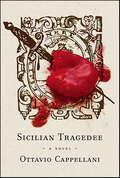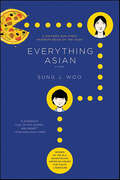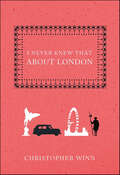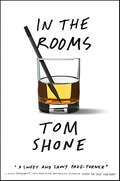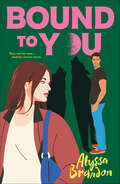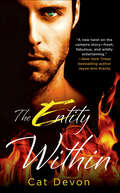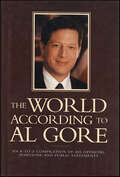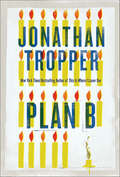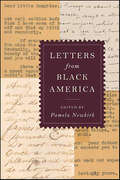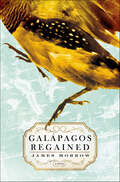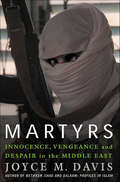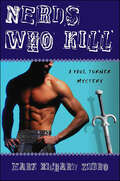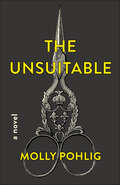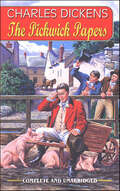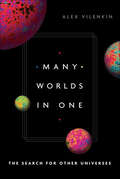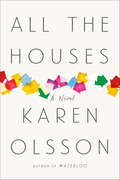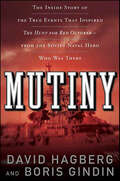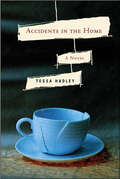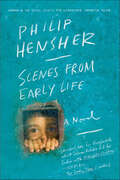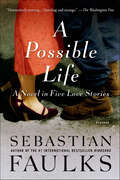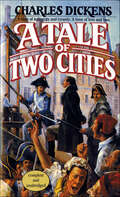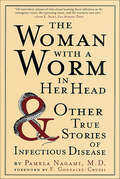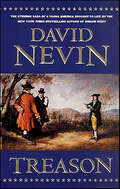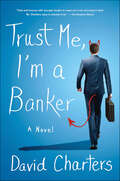- Table View
- List View
Sicilian Tragedee: A Novel
by Ottavio CappellaniBalding, forty-something Mister Alfio Turrisi, an up-and-coming mafioso in Catania, has the deep pockets that London's financial world loves. He, in turn, loves Betty, the spoiled young daughter of Turi Pirrotta, a rival Catanian mobster. Alfio and Betty would seem to be the Romeo and Juliet of this poison-pen valentine to Ottavio Cappellani's native Sicily. That is, until we meet another pair of star-crossed lovers: gay theater director Tino Cagnotto and his bored and sexy young amore, Bobo. Because the way Tino sees it, the real heat in Shakespeare's tragedy is between Romeo and Mercutio, not Romeo and Juliet . . . Set in a twenty-first-century Sicily rife with moody aristocrats, vain politicians, inept gangsters, shabby theater actors, and high-tech killers, Cappellani's hilarious second novel—part Tarantino-style operetta, part soap opera—is also a surprising tribute to the Bard.
Everything Asian: A Novel
by Sung J. WooA funny and incisive Korean family coming-of-age novel in stories about a 12-year-old boy who moves with his mother and sister from Korea to work at their father's Asian gift shop in a New Jersey strip mall--and the growing pains that ensueYou're twelve years old. A month has passed since your Korean Air flight landed at lovely Newark Airport. Your fifteen-year-old sister is miserable. Your mother isn't exactly happy, either. You're seeing your father for the first time in five years, and although he's nice enough, he might be, well--how can you put this delicately?--a loser.You can't speak English, but that doesn't stop you from working at East Meets West, your father's gift shop in a strip mall, where everything is new.Welcome to the wonderful world of David Kim.
I Never Knew That About London
by Christopher WinnDiscover hundreds of fascinating facts about London in this enthralling miscellanyTravelling through the villages and districts that make up the world's most dynamic metropolis, Christopher Winn takes us on a captivating journey around London to unearth the hidden gems of legends, firsts, inventions, adventures and birthplaces that shape the city's compelling and at times turbulent past. See the Chelsea river views that inspired Turner and find out where London's first nude statue is. Explore London's finest country house in Charlton and unearth the secrets of the Mother of Parliaments. Discover which church steeple gave us the design of the traditional wedding cake, where the sandwich was invented and where in Bond Street you can see London's oldest artifact. Visit the house where Handel and Jimi Hendrix both lived. Climb the famous 311 steps of the Monument and fly the world's biggest Ferris wheel. Brimming with stories and snippets providing spellbinding insight into what has shaped the city, I Never Knew That About London is a beautifully illustrated gem of a book that informs and amuses in equal measure."Will not fail to enhance months, even years, of gentle urban exploration...Any number of morning or weekend outings can be constructed from these rich pages... the selections and observations remain unfailingly interesting." --The Guardian (UK)I Never Knew That:Tucked away below Clive Steps at the end of King Charles Street can be found the small underground rooms where Winston Churchill and the War Cabinet met during the air raids of the Second World War. The first-ever Valentine Card was written from the Tower, where in 1415 the recently imprisoned Duke of Orleans composed a love poem to his wife. The measurement of one foot comes from the length of the foot of St. Algar's statue, carved on the base of one of the columns near the entrance of St. Paul's Cathedral. The design for the traditional wedding cake is drawn from the steeple of St. Bride's church in Fleet Street.
In the Rooms
by Tom ShonePart Nick Hornby, part Jay McInerney, with a dash of vermouth, In the Rooms is a warm, sharply observed comedy about sex, lies, drinking, and second chances London literary agent Patrick Miller comes to New York dreaming of joining the big league, only to find himself selling celebrity dog books. But when he spots legendary novelist Douglas Kelsey on the street and follows him into an AA meeting, a world of opportunity beckons. Who knew that sobriety offered such networking possibilities? Or that the women would be so attractive? Soon he's a regular attendee at AA meetings, but there's only one problem—he's not an alcoholic.
Senior Moments: Looking Back, Looking Ahead
by Willard SpiegelmanA moving collection of essays on aging and happinessDrawing on more than six decades' worth of lessons from his storied career as a writer and professor, Willard Spiegelman reflects with candid humor and sophistication on growing old. Senior Moments is a series of discrete essays that, when taken together, constitute the life of a man who, despite Western cultural notions of aging as something to be denied, overcome, and resisted, has continued to relish the simplest of pleasures: reading, looking at art, talking, and indulging in occasional fits of nostalgia while also welcoming what inevitably lies ahead. Spiegelman's expertly crafted book considers, with wisdom and elegance, how to be alert to the joys that brim from unexpected places even as death draws near. Senior Moments is a foray into the felicity and follies that age brings; a consideration of how and what one reads or rereads in late adulthood; the eagerness for, and disappointment in, long-awaited reunions, at which the past comes alive in the present. A clear-eyed book of memories, written in eight searching and courageously honest essays, Senior Moments is guaranteed to stimulate, stir, and restore.
Bound to You
by Alyssa Brandon“When alpha werewolf Megan meets her one true mate . . . she inherits more than she anticipates” in this “quick, enjoyable” teen paranormal romance (School Library Journal).She’s met her mate . . . and he’s met his match.Werewolf Megan Ross has been waiting her whole life for her mate to come and sweep her off her feet. But the wolf she meets on the beach is not the sweet gentle boy she’s been dreaming of. Instead, he’s a warrior, one whose suffering has led him to lock his heart away in a prison as cold and hard as a diamond, who fights to resist the bond and their deep attraction.Far from home, with a soulmate who is still a stranger, Megan learns that the path to true love isn’t quite as straight and easy as she thought . . .Alyssa Brandon’s debut novel Bound to You is guaranteed to make readers swoon, sigh, and maybe even cry before it’s over.“A promising story of how past pain and future expectations can cloud the present.” —Publishers Weekly
The Entity Within
by Cat DevonIS LOVE SOMETHING…Zoe Adams and her grandmother Irma are witches who have been banished from Boston. With nowhere to go, they accept an invitation to come to Chicago...but what they don't realize is that their new space puts them right in the heart of the most dangerous spot of all: Vamptown.YOU CAN SINK YOUR TEETH INTO? Damon Thornheart is just that—virtually untouchable when it comes to love. As Vamptown's highest-ranking demon hunter, he sees red flags when he meets Zoe and Irma, who unwittingly unleashed a brutal evil upon the community. But the more Damon gets to know the stunning, spirited Zoe, the less he understands about his own true nature. Vamps and witches have always been archrivals in the entity world; surrendering to their passion could mean losing their immortal powers. Is their desire worth the risk? Only one thing is for certain: in Entity Within, Damon will make it his mission to find out…"I want Cat Devon's vampires…by the dozen, please!" —Kerrelyn Sparks, bestselling author of Sexiest Vampire Alive
The World According To Al Gore: An A-To-Z Compilation of His Opinions, Positions, and Public Statements
by Joseph KaufmannFor many years Al Gore has been an influential figure in national politics. He may soon become even more significant to the United States and the world.We've gotten to know him via thousands of sound bites and images. For the first time, a cohesive and substantive representation of this man is available. In The World According to Al Gore, the vice president's opinions and statements on a broad spectrum of important topics are assembled in one volume.Here is Al Gore in his own words. This easily accessible, user-friendly volume is presented in an A-to-Z format and contains excerpts from hundreds of speeches, debates, and interviews. These passages span his national political career and give the reader an understanding of Gore's ideas, motivations, and priorities, and the way they have evolved over the last two decades. Read Gore on the environment, family values, drugs, campaign finance, education, parenting, foreign policy, the Internet, and much more.The World According to Al Gore provides insight into Gore the man, the father, the activist, and the politician.
Plan B: A Novel
by Jonathan TropperThe heartwarming debut novel by the New York Times bestselling author of This is Where I Leave You and One Last Thing Before I Go.Turning thirty was never supposed to be like this. Ten years ago, Ben, Lindsey, Chuck, Alison, and Jack graduated from New York University and went out into the world, fresh-faced and full of dreams for the future. But now Ben's getting a divorce; Lindsey's unemployed; Alison and Chuck seem stuck in ruts of their own making; and Jack is getting more publicity for his cocaine addiction than his multimillion-dollar Hollywood successes.Suddenly, turning thirty-- past the age their parents were when they were born, older than every current star athlete or pop music sensation-- seems to be both more meaningful and less than they'd imagined ten years ago.Plan B, Jonathan Tropper's wonderful debut novel, is about more than friendship, love, celebrity, addiction, kidnapping, or even turning thirty-- it's a heartfelt comic riff on what it means to be an adult against your will, to be single when you thought you'd have a family, to discover you are not, in fact, immortal, and to learn that Star Wars is as good a life lesson today as it was when you were six years old.
Letters from Black America
by Pamela NewkirkLetters from Black America fills a literary and historical void by presenting the pantheon of African American experience in the most intimate way possible—through the heartfelt correspondence of the men and women who lived through monumental changes and pivotal events, from the 1700s to the twenty-first century, from slavery to the war in Iraq. The first-ever narrative history of African Americans told through their own letters, this book includes the thoughts of politicians, writers, and entertainers, as well as those of slaves, servicemen, and domestic workers. From a slave who writes to his wife on the eve of being sold to famous documents like Martin Luther King, Jr.'s "Letter from Birmingham Jail," these writings illuminate struggles and triumphs, hardships and glory, in the unforgettable words of the participants themselves. Letters from Black America is an indispensable addition to our country's literary tradition, historical understanding, and self-knowledge.
Galápagos Regained: A Novel
by James MorrowJames Morrow's Galápagos Regained centers on the fictional Chloe Bathurst, an unemployed Victorian actress who finds work on Charles Darwin's estate, nurturing the strange birds, exotic lizards, and giant tortoises he brought back from his trip around the world. When Chloe gets wind of the Great God Contest, sponsored by the Percy Bysshe Shelley Society—£10,000 to the first petitioner who can prove or disprove the existence of a Supreme Being—she decides that Mr. Darwin's materialist theory of speciation might just turn the trick. (If Nature gave God nothing to do, maybe He was never around in the first place.) Before she knows it, her ambitions send her off on a wild adventure—a voyage by brigantine to Brazil, a steamboat trip up the Amazon, a hot-air balloon flight across the Andes—bound for the Galápagos archipelago, where she intends to collect the live specimens through which she might demonstrate evolutionary theory to the contest judges.
Martyrs: Innocence, Vengeance and Despair in the Middle East
by Joyce M. DavisMartyrs offers compelling and chilling interviews with terrorist trainers, with the families of suicide bombers, fighters and fanatics, and with Muslim scholars offering differing opinions on the legitimacy of violence in Islam. Through the voices of those who plan and those who grieve, Martyrs provides provocative and troubling insights into the zealotry that leads to the targeting of innocents, the endless cycle of revenge, and the despair that besets the Middle East. From Iran to Lebanon and the Palestinian territories, Joyce Davis reports on the rage that drives tragedies and at the despondency of the mothers of those who die and kill. Unsettling as the perspectives presented here may be, they are crucial to understanding, though not accepting, the fury at and resentment of the US.
Nerds Who Kill (Paul Turner Mysteries)
by Mark Richard ZubroIn Mark Richard Zubro's Nerds Who Kill, Paul Turner is a widowed father of two teenaged boys, one of whom has spina bifida, rapidly approaching middle age, and used to dealing gracefully with all the challenges these things entail. Turner, however, is slightly different from others in his situation - he's openly gay and a homicide detective for the Chicago Police Department. Despite everything, his personal and family life is relatively placid. Until right now.This time, his life couldn't possibly get more complex and problematic: there's a Science Fiction and Media convention in Chicago this weekend - one of the world's largest such gathering - and his sons are both attending. In full costume. And Paul Turner, like any good father, is going with them. If the prospect of that weren't bad enough, one of the convention's guests - one of the field's most successful fantasy writers - is found murdered, mostly likely by the broadsword found rammed through the corpse's chest. In most circumstances, a broadsword would be a unique murder weapon, but this time there are hundreds of attendees carrying similar ones as part of their costumes. Including his own son.That one gruesome murder is just the beginning - the dead bodies amidst the revelers are starting to pile up - and Turner must sort through a confusing array of suspects in short order if he's to find the killer in time.
The Unsuitable: A Novel
by Molly PohligMolly Pohlig's The Unsuitable is a fierce blend of Gothic ghost story and Victorian novel of manners that’s also pitch perfect for our current cultural moment.Iseult Wince is a Victorian woman perilously close to spinsterhood whose distinctly unpleasant father is trying to marry her off. She is awkward, plain, and most pertinently, believes that her mother, who died in childbirth, lives in the scar on her neck. Iseult’s father parades a host of unsuitable candidates before her, the majority of whom Iseult wastes no time frightening away. When at last her father finds a suitor desperate enough to take Iseult off his hands—a man whose medical treatments have turned his skin silver—a true comedy of errors ensues.As history’s least conventional courtship progresses into talk of marriage, Iseult’s mother becomes increasingly volatile and uncontrollable, and Iseult is forced to resort to extreme, often violent, measures to keep her in check. As the day of the wedding nears, Iseult must decide whether (and how) to set the course of her life, with increasing interference from both her mother and father, tipping her ever closer to madness, and to an inevitable, devastating final act.
The Pickwick Papers
by Charles DickensTor Classics are affordably-priced editions designed to attract the young reader. Original dynamic cover art enthusiastically represents the excitement of each story. Appropriate "reader friendly" type sizes have been chosen for each title—offering clear, accurate, and readable text. All editions are complete and unabridged, and feature Introductions and Afterwords.This edition of The Pickwick Papers includes a Foreword, Biographical Note, and Afterword by Nancy Springer. The Pickwick Club was founded by the most learned minds in London for the purpose of making a scientific tour of the world. Its distinguished members include Mr. Samuel Pickwick, Esq., G.C.M.PC., presiding; Augustus Snodgrass; Nathaniel Winkle; and Tracy Tupman, Esq. Yet no sooner have these gentlemen begun their historic journey than they are set upon by a charming but notorious con man, Alfred Jingle. So begins a series of hilarious misadventures that takes the incorrigibly innocent Pickwicks wandering around England, coming in contact with some of the most colorful and comical characters in all fiction, including Dr. Slammer, Dismal Jemmy Hutley, Job Trotter, Wilkins Flasher, and Mr. Serjeant Buzfuz.This was Dickens' first novel--and remains his funniest and most loved.At the Publisher's request, this title is being sold without Digital Rights Management Software (DRM) applied.
Many Worlds in One: The Search for Other Universes
by Alex VilenkinA Leading Figure in the Development of the New Cosmology Explains What It All MeansAmong his peers, Alex Vilenkin is regarded as one of the most imaginative and creative cosmologists of our time. His contributions to our current understanding of the universe include a number of novel ideas, two of which—eternal cosmic inflation and the quantum creation of the universe from nothing—have provided a scientific foundation for the possible existence of multiple universes. With this book—his first for the general reader—Vilenkin joins another select group: the handful of first-rank scientists who are equally adept at explaining their work to nonspecialists. With engaging, well-paced storytelling, a droll sense of humor, and a generous sprinkling of helpful cartoons, he conjures up a bizarre and fascinating new worldview that—to paraphrase Niels Bohr—just might be crazy enough to be true.
All the Houses: A Novel
by Karen OlssonA bittersweet, biting, sharply observed family drama from the author of WaterlooAfter her father has a heart attack and subsequent surgery, Helen Atherton returns to her hometown of Washington, D.C., to help take care of him and, perhaps more honestly, herself. She's been living in Los Angeles, trying to work in Hollywood, slowly spiraling into a depression fueled by hours spent watching C-SPAN-her obsession with politics a holdover from a childhood interrupted by her father's involvement in the Iran-Contra scandal. "I don't know whether to think of him as a coconspirator or a complicit bystander or just someone who was in the wrong place at the wrong time." Though the rest of the world has forgotten that scandal, the Atherton family never quite recovered. While living with her father in her childhood home, Helen tries to piece together the political moves that pulled her family apart.All the Houses is, at its heart, a father-daughter story. With razor-sharp prose, an alluring objectivity, and a dry sense of humor, Karen Olsson writes about the shape-shifting of our family relationships when outside forces work their way in-how Washington turns people into unnatural versions of themselves, how problematic and overbearing sisters can be, and how familial nostalgia that sets in during early adulthood can prove counterproductive to actually becoming an adult.
Mutiny: The Inside Story of the True Events That Inspired The Hunt for Red October—from the Soviet Naval Hero Who Was There
by David Hagberg Boris GindinThe amazing true story behind the mutiny that inspired Tom Clancy's The Hunt for Red October, by USA Today bestselling author David Hagberg and Boris Gindin, a Senior Lieutenant in the Russian navy, who stopped the mutiny and lived to tell about it. In 1984, Tom Clancy released his blockbuster novel, The Hunt for Red October, an edge-of-your seat thriller that skyrocketed him into international notoriety. The inspiration for that novel came from an obscure report by a US naval officer of a mutiny aboard a Soviet warship in the Baltic Sea. The Hunt for Red October actually happened, and Boris Gindin lived through every minute of it. After decades of silence and fear, Gindin has finally come forward to tell the entire story of the mutiny aboard the FFG Storozhevoy, the real-life Red October.It was the fall of 1975, and the tensions between the Soviet Union and the United States were climbing. It seemed the two nations were headed for thermonuclear war, and it was that fear that caused most of the crewman of the FFG Storozhevoy to mutiny. Their goal was to send a message to the Soviet people that the Communist government was corrupt and major changes were needed. That message never reached a single person. Within hours the orders came from on high to destroy the Storozhevoy and its crew members. And this would have happened if it weren't for Gindin and few others whose heroism saved many lives.Now, with the help of USA Today bestselling author David Hagberg, Gindin relives every minute of that harrowing event. From the danger aboard the ship to the threats of death from the KGB to the fear that forced him to flee the Soviet Union for the United States, Mutiny reveals the real-life story behind The Hunt for Red October and offers an eye-opening look at the Soviet Union during the height of the Cold War.At the Publisher's request, this title is being sold without Digital Rights Management Software (DRM) applied.
Accidents in the Home: A Novel
by Tessa HadleyA powerful literary debut chronicling a year in the life of one thoroughly modern familyClare Verey, a twenty-nine-year-old mother of three, bakes her own bread and grinds her own spices. She has a comfortable home in the suburbs and a devoted husband. Why is it, then, that when her best friend's lover appears in her life he has the power to invert her world? Why is the desire for more never satisfied?So begins Accidents in the Home, a novel that exposes the emotional underbelly of a modern-day family. Clare's narrative is deftly intertwined with the stories of her extended family: her mother, Marian, the clever daughter of a Dostoevsky scholar whose husband leaves her for a beautiful young art student; Clare's half brother, Toby, a dreamy boy who prefers to view life through the lens of a camera; her troubled younger half sister, Tamsin, who develops an apparatus of taboos and rituals to restore order to her chaotic past. In the world Tessa Hadley has created, family is no longer a steady foundation but a complex web of marriages, divorces, half siblings, and stepchildren that expands with every new connection and betrayal. Accidents in the Home offers a startling, intimate portrait of family life in our time.
Scenes from Early Life: A Novel
by Philip HensherFrom the Man Booker–short-listed author of The Northern Clemency, a family and a nation—Bangladesh—are forged through storytelling, conversation, jokes, feuds, blood, songs, bravery, and sacrifice In late 1970 a boy named Saadi is born into a large, defiantly Bengali family in eastern Pakistan. Months later the country splits in two, in what will become one of the most ferocious twentieth-century civil wars. Saadi tells the story of his childhood and of the ingenious ways his family survived the violence and conflicts: from his aunts stuffing him endlessly with sweets to stop marauding soldiers from hearing him cry, to street games based on American television shows; from the basement compartment his grandfather built to hide his treasured books, pictures, and music until after the war, to the daily gossip about each and every one of the relatives, servants, and neighbors. Scenes from Early Life is a beautifully detailed novel of profound empathy—an attempt to capture the collective memory of a family and a country. At once heartbreaking and surprisingly funny, Scenes from Early Life is based on the life of Philip Hensher's husband, and as such it is at once a memoir, a novel, and a history. As this remarkable writer brings the past to life, we come to feel, vividly and viscerally, that Saadi's family—and its struggles and triumphs—are our own. Scenes form Early Life is the winner of the 2013 Royal Society of Literature Ondaatje Prize for a distinguished work of fiction, non-fiction or poetry, evoking the spirit of a place.
A Possible Life: A Novel in Five Love Stories
by Sebastian FaulksFrom the critically acclaimed, bestselling author of Birdsong, new fiction about love and war—five transporting stories and five unforgettable lives, linked across centuries.In Second World War Poland, a young prisoner closes his eyes and pictures going to bat on a sunlit English cricket ground.Across the yard of a Victorian poorhouse, a man is too ashamed to acknowledge the son he gave away.In a 19th-century French village, an old servant understands—suddenly and with awe—the meaning of the Bible story her master is reading to her.On a summer evening in the Catskills in 1971, a skinny girl steps out of a Chevy with a guitar and with a song that will send shivers through her listeners' skulls.A few years from now, in Italy, a gifted scientist discovers links between time and the human brain and between her lover's novel and his life.Throughout the five masterpieces of fiction that make up A Possible Life, exquisitely drawn and unforgettable characters risk their bodies, hearts and minds in pursuit of the manna of human connection. Between soldier and lover, parent and child, servant and master, and artist and muse, important pleasures and pains are born of love, separations and missed opportunities. These interactions—whether successful or not—also affect the long trajectories of characters' lives.Provocative and profound, Sebastian Faulks's dazzling new novel journeys across continents and centuries not only to entertain with superb old-fashioned storytelling but to show that occasions of understanding between humans are the one thing that defines us—and that those moments, however fluid, are the one thing that endures.
A Tale of Two Cities
by Charles DickensTor Classics are affordably-priced editions designed to attract the young reader. Original dynamic cover art enthusiastically represents the excitement of each story. Appropriate "reader friendly" type sizes have been chosen for each title—offering clear, accurate, and readable text. All editions are complete and unabridged, and feature Introductions and Afterwords.This edition of A Tale of Two Cities includes a Foreword, Biographical Note, and Afterword by R.L. Fisher.They fled to London, seeking safety, and found each other--Dr. Manette, falsely imprisoned for decades; his daughter, Lucie, whose stunning beauty was matched by her loyalty and grace; and Charles Darnay, who abandoned a royal title he hated to risk being called a traitor in France, a spy in England. Together, their love touched the hearts of even stodgy banker Mr. Lorry and cynical, jaded lawyer Sydney Carton...But in Paris, the fires of revolution exploded in uncontrollable fury. The noble goals of freedom fighters became the crazed bloodbath called the Reign of Terror. And when three exiles returned home on an errand of mercy, they were trapped in a nightmare of mock trials and made rage. Once in Paris, nothing could save Darnay, Lucie, or Manette...Except a miracle.At the Publisher's request, this title is being sold without Digital Rights Management Software (DRM) applied.
The Woman with a Worm in Her Head: & Other True Stories of Infectious Disease
by Pamela NagamiA normal, healthy woman becomes host to a pork tapeworm that is burrowing into her brain and disabling her motor abilities. A handsome man contracts Chicken Pox and ends up looking like the victim of a third degree burn. A vigorous young athlete is bitten by an insect and becomes a target for flesh-eating strep.Even the most innocuous everyday activities such as eating a salad for lunch, getting bitten by an insect, and swimming in the sea bring human beings into contact with dangerous, often deadly microorganisms. In The Woman with a Worm in Her Head, Dr. Pamela Nagami reveals-through real-life cases-the sobering facts about some of the world's most horrific diseases: the warning signs, the consequences, treatments, and most compellingly, what it feels like to make medical and ethical decisions that can mean the difference between life and death.Unfailingly precise, calmly instructive, and absolutely engrossing, The Woman with the Worm in Her Head offers both useful information and enjoyable reading.
Treason (The American Story)
by David NevinThis is a story of ambitions and dreams shattered. It is a tale of intrigue and greed, surrounding the powerful figures in history, who are unable to see the consequences of their visions. It is the story of a young democracy.At the Publisher's request, this title is being sold without Digital Rights Management Software (DRM) applied.
Trust Me, I'm a Banker: A Novel
by David ChartersIn the tradition of American Psycho comes this hilariously cynical and often-brutal novel skewering the world of investment banking, set in the heart of London high financeMeet Dave Hart, just your typical investment banker. It's not long until Bonus Day, the most important day of the year, and anything less than a million pounds would be an insult. After all, Dave has to buy a new car, a new Rolex for his wife, and a second home in the country. Not to mention support a few personal habits, legal or otherwise, that gentlemen bankers don't discuss in public. Unfortunately, a million really isn't what it used to be, and no one else seems to value Dave as much as he knows he's worth. Luckily, competence and charm have never been accurate barometers for success in high finance, and Dave just might be able to weasel and blunder his way to the top.Extremely funny and razor-sharp, Trust Me, I'm a Banker is the tale of one man's quest for outrageous compensation and alpha status in a world where pitiless ambition, insecurity, and moral ambiguity are second nature and glitter is far more important than gold. This flawless social satire is a highly enjoyable voyeuristic glimpse into our modern culture of narcissism, materialism, and bottomless greed.
